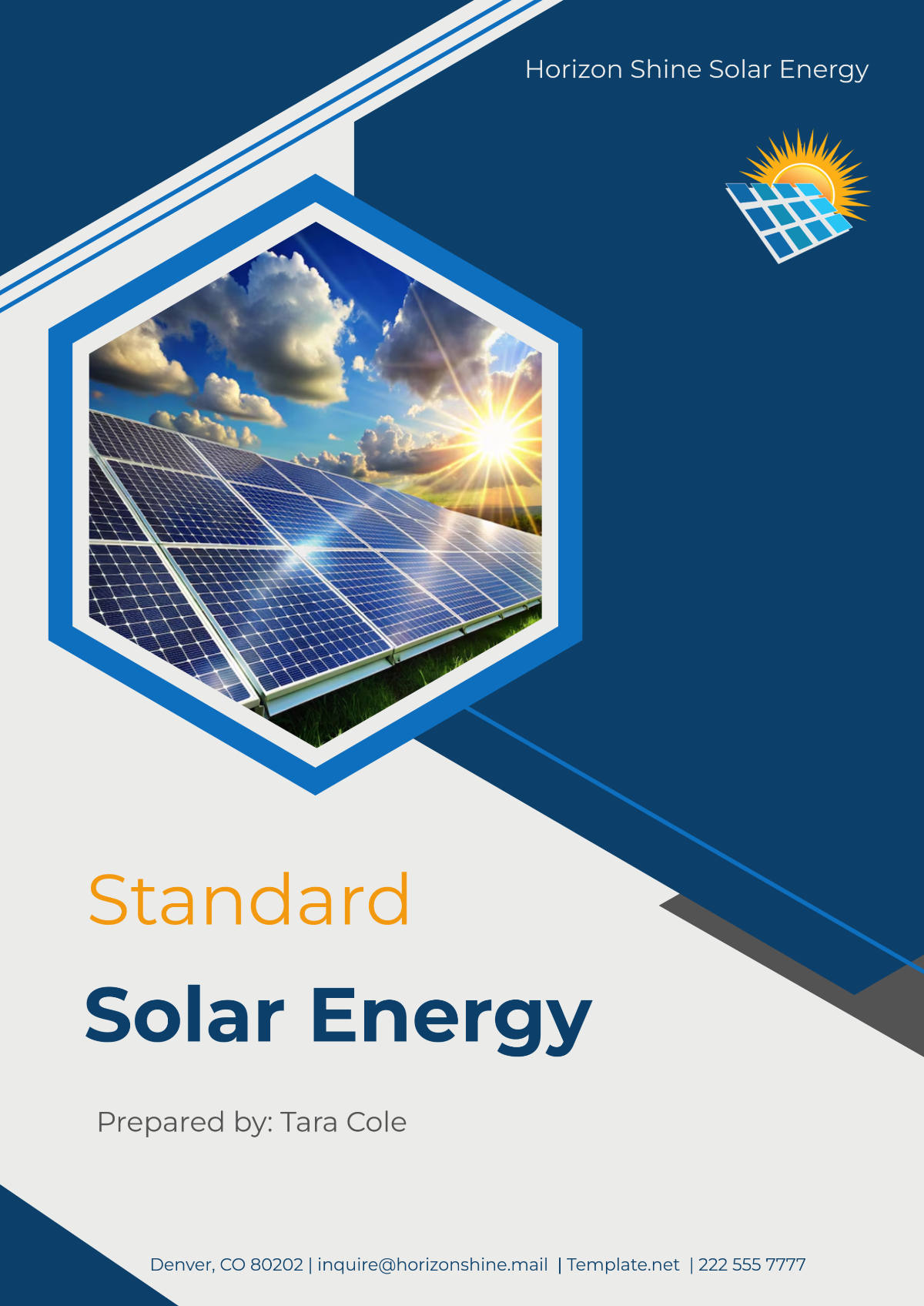Free Solar Energy Feasibility Study

1. Introduction
1.1 Purpose of the Study
The primary purpose of this Solar Energy Feasibility Study is to evaluate the technical, economic, and environmental viability of a solar energy project initiated by [Your Company Name]. As the world increasingly faces the consequences of climate change, transitioning to renewable energy sources has become imperative. This study aims to provide a comprehensive analysis of the potential for solar energy adoption in the designated project area, specifically focusing on solar photovoltaic (PV) systems. The insights garnered from this study will inform strategic decision-making regarding investment levels, technological choices, and project execution methods, ultimately contributing to the broader goals of sustainable development and energy security.
1.2 Scope of the Study
This feasibility study encompasses a detailed examination of the solar energy market, technical aspects, economic implications, and environmental impacts. The study will include the following areas:
Market Analysis: A thorough exploration of the current state of the solar energy market, recent trends, and future projections. This section will highlight the growth potential of solar energy in light of technological advancements and changing consumer preferences.
Technical Feasibility: An in-depth assessment of the proposed site, including land characteristics, solar resource availability, and the evaluation of various solar technologies.
Economic Feasibility: A comprehensive cost analysis of the project, including capital and operational expenditures, revenue projections, and an assessment of financial viability through metrics such as ROI and payback period.
Environmental Impact: An evaluation of the environmental benefits associated with the project, including greenhouse gas reduction and potential ecological impacts, along with mitigation strategies.
Implementation Strategy: A roadmap outlining the steps necessary for project execution, including timelines, regulatory requirements, and project management practices.
1.3 Methodology
The methodology for this feasibility study includes a combination of qualitative and quantitative analyses, ensuring a holistic evaluation of the proposed solar project. Key steps in this process include:
Data Collection: Gathering relevant data from a variety of sources, including government publications, industry reports, and academic research. This information will form the basis of market and technical analyses.
Site Evaluations: Conducting on-site assessments and utilizing geographic information system (GIS) tools to analyze topography, land use, and proximity to infrastructure.
Financial Modeling: Developing detailed financial models to assess costs, revenues, and investment returns. These models will incorporate realistic assumptions based on historical data and industry benchmarks.
Stakeholder Engagement: Engaging with various stakeholders—including local government officials, community members, and potential partners—to gather insights and validate findings. This collaborative approach ensures that all perspectives are taken into account and fosters community support for the project.
2. Project Overview
2.1 Project Location
The proposed solar energy project is strategically located in Phoenix, Arizona, a region known for its favorable climatic conditions and abundant sunlight. Phoenix, located in the heart of the Sonoran Desert, experiences over [300] sunny days per year, making it an ideal location for solar energy generation. This area has been carefully selected based on various factors, including solar irradiance levels, accessibility to transportation and grid infrastructure, and the absence of significant land use conflicts. The geographic coordinates are approximately [33.4484° N] latitude and [112.0740° W].
Additionally, the proximity to urban areas enhances the viability of energy distribution to local consumers. The existing power infrastructure in Phoenix is well-developed, allowing for efficient grid connection and minimizing the costs associated with energy transmission. This factor is critical, as it will reduce potential bottlenecks in energy distribution, ensuring that generated power can be utilized effectively and promptly.
2.2 Project Description
The project aims to install a solar photovoltaic (PV) system with a total capacity of [5] MW. This capacity has been carefully determined based on an analysis of local energy demands, allowing the system to effectively contribute to the regional grid. The proposed system will utilize high-efficiency solar panels and advanced inverter technology to optimize energy generation, thus maximizing the economic return.
It is anticipated that the system will produce approximately [8,400] MWh of electricity per year. This substantial output will not only meet local energy needs but will also contribute to reducing overall greenhouse gas emissions, thereby supporting global climate change mitigation efforts. Additionally, the project is expected to create approximately [15] full-time jobs during the installation phase and around [5] permanent positions for ongoing maintenance and operations.
2.3 Stakeholders
The successful implementation of the solar energy project relies on the collaboration and support of various stakeholders, each playing a critical role in the project’s development. Key stakeholders involved in this project include:
[Your Company Name]: As the project developer and primary investor, [Your Company Name] is responsible for project financing, management, and execution. The company’s experience in renewable energy projects will be instrumental in ensuring the successful development of this solar installation.
Local Government: The involvement of local authorities is essential for obtaining permits and ensuring compliance with zoning and environmental regulations. Their support can also facilitate community acceptance of the project, as they are key figures in communicating the project’s benefits to the public.
Utility Providers: Partnering with local utility companies will be crucial for establishing energy off-take agreements that allow for the sale of generated power back to the grid. Such partnerships are vital for securing a reliable revenue stream and ensuring that the electricity generated can be effectively integrated into the local energy market.
Community Members: Local residents will be impacted by the project, making their support essential. Engaging the community early in the process will help address concerns and highlight potential benefits, such as job creation and access to clean energy. Efforts will include informational meetings, outreach programs, and community workshops to foster transparency and collaboration.
3. Market Analysis
3.1 Current Solar Market Trends
The global solar market has witnessed unprecedented growth over the past decade, characterized by a compound annual growth rate (CAGR) of approximately [20%] from 2050 to 2060. By 2060, the demand for solar energy is projected to increase significantly as governments and corporations strive for net-zero carbon emissions in response to climate change. The following trends are particularly noteworthy:
Increased Adoption of Solar Technology: Solar energy systems are gaining traction among residential, commercial, and industrial sectors, driven by advancements in technology and falling costs. This broad adoption signifies a shift toward cleaner energy alternatives, with many companies committing to sustainability goals that include solar energy as a key component.
Cost Reduction: The costs associated with solar panels and related equipment have decreased by [70%] over the past [10] years, making solar energy increasingly accessible to a wider range of consumers and businesses. This trend is expected to continue as technological advancements and economies of scale are realized, allowing for further reductions in installation costs.
Innovations in Energy Storage: The integration of battery storage systems is becoming more common, enhancing the reliability of solar energy as a power source. These systems allow for energy produced during peak sunlight hours to be stored and used during periods of high demand or low sunlight, significantly improving the economic feasibility of solar installations.
Corporate Commitments: An increasing number of corporations are setting ambitious renewable energy goals. For instance, companies like Google and Apple have committed to using 100% renewable energy in their operations, driving further investment in solar projects and contributing to the growth of the market.
3.2 Government Policies and Incentives
Government policies are pivotal in shaping the landscape for solar energy adoption. A variety of incentives that could significantly impact the project's viability include:
Tax Credits: Federal and state tax credits for solar installations, such as the Investment Tax Credit (ITC), provide substantial financial relief to project developers and homeowners alike. These incentives can reduce the overall cost of installation and improve ROI. For instance, the ITC is set at [30%] for installations completed before 2052. Additionally, some states offer additional incentives, which can further enhance the project’s economic attractiveness.
Renewable Energy Certificates (RECs): Programs that allow energy producers to sell certificates representing renewable energy generation provide an additional revenue stream. These certificates can be sold to utilities that need to meet renewable energy mandates, further incentivizing the adoption of solar energy projects.
Net Metering Policies: Regulations allowing solar energy producers to offset their energy costs by selling excess energy back to the grid can significantly improve the economic feasibility of solar projects. This allows for greater financial returns, particularly in regions with high energy prices.
State Renewable Portfolio Standards (RPS): Many states have established RPS that require a certain percentage of energy to be generated from renewable sources. These standards create a guaranteed market for renewable energy, further enhancing the viability of solar projects.
3.3 Competition Analysis
Understanding the competitive landscape is essential for positioning the project effectively within the market. Key factors to consider include:
Local Competitors: Several established solar companies operate in the Phoenix area, offering a range of products and services. These competitors include both large-scale developers and smaller local installers. Assessing their strengths and weaknesses will allow [Your Company Name] to identify opportunities for differentiation.
Technological Edge: By adopting advanced technologies, such as bifacial solar panels and smart inverters, the project can achieve higher efficiency rates and better overall performance compared to competitors. This technological edge can serve as a strong selling point to potential clients and stakeholders.
Customer Service: Providing exceptional customer service and support can enhance [Your Company Name]'s reputation in the market. Engaging with customers throughout the installation process and providing ongoing support can foster loyalty and positive word-of-mouth referrals, which are invaluable for future business.
Pricing Strategies: Competitive pricing will be critical in attracting customers. Conducting a thorough analysis of competitor pricing and ensuring that [Your Company Name]'s pricing structure is both attractive and sustainable will be necessary to gain market share while maintaining profitability.
4. Technical Feasibility
4.1 Site Assessment
A comprehensive site assessment is crucial for determining the viability of the solar project. The evaluation includes:
Topography and Land Use: The site is primarily flat, which is favorable for solar installations as it minimizes land preparation costs. Existing land use patterns will be considered to ensure compatibility with solar operations. The surrounding area is largely undeveloped, reducing potential conflicts with agricultural or residential uses. This aspect is essential in securing community support and ensuring compliance with zoning laws.
Soil Conditions: Soil stability and composition will be evaluated to determine the appropriate foundation design for the solar arrays. Testing will be conducted to ensure that the ground can adequately support the weight of the structures and withstand local weather conditions, such as high winds and heavy rains.
Accessibility: The site’s accessibility to transportation infrastructure, such as roads and electrical grid connections, will facilitate the transport of equipment and materials during the installation phase. Proximity to major highways and utility lines will help reduce logistics costs and expedite the connection to the grid.
4.2 Solar Resource Assessment
The solar resource assessment involves the evaluation of solar irradiance levels at the proposed site. Key components of this assessment include:
Solar Irradiance Data: Historical solar irradiance data will be analyzed to determine the average daily sunlight exposure. The assessment indicates an average solar irradiance of approximately [5.5] kWh/m²/day for the project site. This figure highlights the site’s suitability for solar energy generation and allows for accurate calculations of potential energy output.
Seasonal Variations: The assessment will also evaluate seasonal variations in solar exposure, allowing for accurate projections of energy production throughout the year. The peak months for solar generation are anticipated to be May through August, with lower outputs in the winter months. This seasonal data will be crucial for financial forecasting and energy sales strategies.
4.3 Technology Options
The selection of appropriate technology is crucial for optimizing the performance of the solar energy system. The following advanced technologies will be evaluated:
Monocrystalline Solar Panels: These panels, characterized by their high efficiency and space-saving design, are estimated to yield an efficiency rating of approximately [20%]. They are recommended for the project due to their superior performance in low-light conditions, making them ideal for the project site. Furthermore, their sleek appearance can contribute to positive public perception.
Bifacial Solar Panels: Capable of capturing sunlight from both sides, bifacial panels can increase energy production by an estimated [10-15%] compared to traditional panels. This increase is particularly beneficial in areas with reflective ground surfaces, thus enhancing the project’s overall efficiency. The use of bifacial technology represents an innovative approach that maximizes output while minimizing land use.
Smart Inverters: The integration of smart inverter technology will enhance system monitoring and performance optimization, ensuring that energy production is maximized while maintaining grid stability. Smart inverters provide real-time data analytics, which facilitates proactive management of the solar energy system. This technology enables dynamic responses to grid conditions and improves overall system reliability.
4.4 System Design
The preliminary system design will be based on the site assessment and solar resource evaluation. Key design elements include:
Array Configuration: The solar arrays will be configured to maximize sunlight exposure while considering potential shading from nearby structures or vegetation. The optimal tilt and orientation will be calculated to enhance energy production throughout the year. The design will incorporate a [25]-degree tilt angle and will be oriented southward to capture maximum sunlight. Detailed simulations will be performed to model energy production under various weather conditions, ensuring that the system design is robust and adaptable.
Energy Storage Solutions: Battery storage systems will be incorporated to store excess energy generated during the day for use during peak demand periods or at night. A storage capacity of [1.5] MWh is proposed, which will increase the system's overall reliability and efficiency, allowing for energy to be dispatched as needed. This solution will be particularly valuable in managing energy consumption patterns and reducing peak demand pressures on the grid.
Monitoring Systems: Advanced monitoring systems will be installed to track performance in real-time, allowing for prompt identification and resolution of issues to minimize downtime. These systems will include remote monitoring capabilities, enabling operators to assess system performance from anywhere. By utilizing cutting-edge technology, the project will ensure optimal operation and maintenance practices, thereby extending the lifespan of the solar installation.
5. Economic Feasibility
5.1 Cost Analysis
A comprehensive cost analysis provides insight into the financial requirements and potential profitability of the project. The key components of the cost analysis include:
Capital Expenditures (CAPEX): Initial investments required for equipment, installation, and infrastructure are projected to be approximately $[2,500,000]. This includes costs for solar panels, inverters, mounting structures, labor, and permitting. A detailed breakdown is provided below:
Cost Component | Estimated Cost ($) |
|---|---|
Solar Panels | [1,200,000] |
Inverters | [400,000] |
Mounting Structures | [300,000] |
Installation Labor | [450,000] |
Permitting Fees | [150,000] |
Maintenance (Annual) | [100,000] |
This CAPEX analysis takes into account potential fluctuations in market prices for solar equipment and labor. Continuous monitoring of the supply chain and engagement with multiple suppliers will help mitigate risks associated with cost overruns.
Operational Expenditures (OPEX): Ongoing operational costs, including maintenance, insurance, and administrative expenses, are estimated at $[100,000] per year. Regular maintenance will be essential to ensure optimal performance and longevity of the system. The OPEX estimation includes:
OPEX Component | Estimated Annual Cost ($) |
|---|---|
Routine Maintenance | [40,000] |
Insurance | [30,000] |
Administrative Expenses | [30,000] |
The development of a maintenance schedule will be crucial to maximize the efficiency and lifespan of the solar installation.
5.2 Financial Projections
Financial projections will provide an overview of expected revenue and expenses over the project’s lifespan. Key financial metrics include:
Annual Energy Revenue: Based on the estimated annual production of [8,400 MWh], projected revenue from energy sales is approximately $[420,000] annually. This estimate assumes an average energy sale price of $[50 per MWh]. Revenue projections are based on a conservative assessment of energy prices, allowing for variability in market conditions.
Payback Period: The expected payback period for the initial investment is calculated to be [5.95] years, indicating the time required to recoup the initial investment through energy sales. This calculation is based on net cash flows and will be monitored regularly to account for any changes in operational costs or energy pricing.
5.3 Return on Investment (ROI)
Based on the projected revenue and expenses, the ROI is estimated to be [16.7]% over a [20] year period, highlighting the project’s potential to generate significant returns for investors. This positive ROI demonstrates the financial attractiveness of the solar energy project and its ability to contribute to [Your Company Name]'s overall growth strategy.
5.4 Sensitivity Analysis
Sensitivity analysis will be conducted to evaluate how changes in key variables impact financial performance. Factors to be considered include:
Energy Prices: Fluctuations in energy prices can significantly affect revenue. A scenario where energy prices decrease by [20%] will be modeled to assess the impact on ROI. Conversely, scenarios where energy prices increase will also be examined to understand potential upside.
Installation Costs: Changes in CAPEX will also be analyzed, as an increase in installation costs of [10%] could extend the payback period and reduce profitability. This analysis will help identify cost management strategies to mitigate financial risks.
Operational Efficiency: Variations in energy production efficiency due to technological advancements or system failures will be examined. A [5%] decrease in energy production could lead to a significant reduction in annual revenue, prompting the need for contingency planning.
By conducting this sensitivity analysis, [Your Company Name] can better prepare for potential financial challenges and make informed decisions regarding risk management strategies.
6. Environmental Impact Assessment
6.1 Environmental Benefits
The solar energy project presents numerous environmental benefits that contribute to sustainability and ecological preservation. Key benefits include:
Reduction in Greenhouse Gas Emissions: By generating clean energy, the project is expected to offset approximately [4,000 tons] of CO2 emissions annually. This substantial reduction in greenhouse gases will contribute to climate change mitigation efforts and align with global sustainability goals.
Conservation of Natural Resources: Solar energy is a renewable resource that reduces dependence on fossil fuels, thereby preserving natural resources for future generations. The project's contribution to the local energy supply will promote energy independence and resilience.
Biodiversity Preservation: The project is designed with minimal land disturbance, ensuring that local ecosystems remain intact. Proper site management practices will be implemented to minimize any potential impacts on local flora and fauna, promoting biodiversity in the area.
6.2 Environmental Risks and Mitigation
While the solar project offers significant environmental benefits, potential risks must also be identified and managed. Key risks include:
Land Use Conflicts: The project site may conflict with existing land uses or local wildlife habitats. Mitigation measures, such as conducting thorough environmental assessments and engaging with local stakeholders, will help address potential conflicts. Additionally, the project design will include buffers to protect sensitive areas and minimize ecological disruptions.
Waste Management: End-of-life management of solar panels presents a potential environmental risk. [Your Company Name] will implement a recycling program to ensure responsible disposal and recovery of materials from decommissioned solar panels. Collaborating with certified recycling facilities will ensure compliance with environmental regulations and promote circular economy practices.
Visual and Aesthetic Impacts: The installation of solar arrays may alter the visual landscape of the area. To address this concern, [Your Company Name] will engage in community outreach to educate the public about the benefits of solar energy and work to design installations that blend harmoniously with the local environment. Efforts will include landscaping and utilizing color palettes that are visually appealing and complementary to the surroundings.
7. Implementation Plan
7.1 Project Timeline
The project implementation timeline is structured to ensure efficient progress from initial planning to full operational status. The timeline is divided into key phases:
Phase | Duration | Timeline |
|---|---|---|
Pre-Development | [6 months] | January 2050 - June 2050 |
Permitting and Approvals | [4 months] | July 2050 - October 2050 |
Procurement and Installation | [8 months] | November 2050 - June 2051 |
Testing and Commissioning | [2 months] | July 2051 - August 2051 |
Operational Phase | Ongoing | September 2051 onward |
This detailed timeline will be monitored closely to ensure adherence to project milestones and deadlines. Any potential delays will be addressed proactively to minimize disruptions and maintain stakeholder confidence.
7.2 Regulatory Approvals
Obtaining the necessary regulatory approvals is critical for project success. Key steps include:
Zoning Approvals: Application for zoning changes or variances will be submitted to local authorities to ensure compliance with land use regulations. This process typically requires public hearings and community engagement to address potential concerns.
Environmental Permits: Environmental impact assessments will be conducted to evaluate potential impacts and obtain necessary permits from state and federal regulatory bodies. Engaging with environmental consultants will ensure that all regulations are met, and mitigation measures are implemented.
Interconnection Agreements: Agreements with local utility companies will be established to facilitate the connection of the solar installation to the grid. These agreements outline the terms for energy sales and grid access, ensuring a smooth integration of the solar project into the local energy network.
7.3 Project Management
Effective project management practices will be essential for the successful execution of the solar energy project. Key management strategies include:
Project Team Formation: A dedicated project team will be established, comprising experts in engineering, finance, environmental science, and community relations. Each team member will be responsible for specific project components, ensuring accountability and effective communication.
Risk Management Plan: A comprehensive risk management plan will be developed to identify potential risks and outline mitigation strategies. Regular assessments will be conducted to monitor risk levels and adjust strategies as necessary.
Stakeholder Communication: Ongoing communication with stakeholders will be prioritized to ensure transparency and address concerns. Regular updates will be provided through newsletters, community meetings, and social media platforms, fostering positive relationships with the public and local government.
8. Conclusion
8.1 Summary of Findings
The comprehensive feasibility study conducted by [Your Company Name] has demonstrated that the proposed solar energy project in Phoenix, Arizona, is both technically and economically viable. The region's abundant solar resource, combined with supportive government policies and a growing demand for renewable energy, positions the project favorably within the market. Additionally, the project's environmental benefits and community engagement strategies will contribute to a positive public perception and support sustainable development goals.
8.2 Recommendations
Based on the findings of this feasibility study, the following recommendations are proposed:
Proceed with Project Development: Given the positive financial projections and environmental benefits, [Your Company Name] should proceed with the development of the solar energy project. This investment aligns with the company’s strategic goals and commitment to sustainability.
Engage in Community Outreach: A robust community outreach program should be established to educate local residents about the benefits of solar energy and address any concerns. By fostering a positive dialogue, [Your Company Name] can build community support and ensure the project’s success.
Monitor Market Trends: Continuous monitoring of solar market trends, technological advancements, and policy changes will be essential to adapt the project strategy as needed. Staying informed will allow [Your Company Name] to capitalize on emerging opportunities and navigate potential challenges effectively.
By following these recommendations and leveraging the comprehensive analysis presented in this feasibility study, [Your Company Name] is well-positioned to successfully implement the solar energy project, contributing to a sustainable energy future and benefiting both the local community and the environment.
- 100% Customizable, free editor
- Access 1 Million+ Templates, photo’s & graphics
- Download or share as a template
- Click and replace photos, graphics, text, backgrounds
- Resize, crop, AI write & more
- Access advanced editor
Evaluate project viability with the Solar Energy Feasibility Study Template from Template.net. This editable and customizable template guides you through assessing site conditions, resource availability, and financial implications. Utilize our Ai Editor Tool to tailor it for specific projects, ensuring thorough and informed decision-making.





























